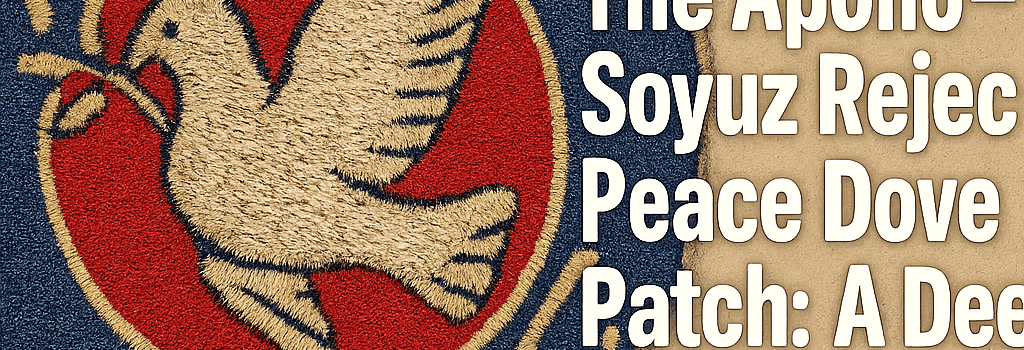The Apollo–Soyuz Rejected Peace Dove Patch: A Deep Dive

Introduction
On July 15, 1975, the Apollo–Soyuz Test Project (ASTP) marked the first international docking in low Earth orbit, uniting three NASA astronauts and two Soviet cosmonauts. While the flight itself became a symbol of détente, the original mission insignia featuring a peace dove and olive branch was surprisingly rejected by NASA. This article reconstructs the story with added technical context, expert insights, and fresh developments on space mission iconography.
Original Patch Submission and Rejection
Veteran space artist Paul Calle, one of the founding members of NASA’s Art Program, was commissioned to design the ASTP patch after an internal contest entry was deemed insufficiently “international.” Calle’s leading concept depicted:
- A white dove clutching an olive branch
- A stylized rendering of Earth with the U.S. and Soviet Union highlighted
- Interlocking silhouettes of the Apollo and Soyuz spacecraft
- Options with and without crew names in custom calligraphy
“Our first choice for a patch… has been disapproved,” wrote astronaut Deke Slayton. “It seems the powers that be are not that into peace doves and olive branches at the moment.”
Political and Cultural Context
Despite Soviet leader Leonid Brezhnev later hailing ASTP as “a symbol of the improvement of Soviet–US relations,” NASA’s administration worried that overt peace iconography might blur public perception of the space program’s scientific and technological goals. Gerald Ford nonetheless praised the mission as essential “to ensure peace,” while internal memos referenced concerns about Cold War propaganda.
Technical Analysis of Patch Design
From a materials-engineering perspective, mission patches in the 1970s used a three-layer construction:
- Face Fabric: Tight-weave twill cotton for fine embroidery detail
- Interliner: Stiffening felt for shape retention at +120 °C
- Backing: Adhesive or velour for uniform heat-bond application to flight suits
Calle’s proposed color palette incorporated nine Pantone shades, including PMS 187C (Soviet red) and PMS 2935C (NASA blue), challenging embroiderers to maintain colorfastness under vacuum-thermal cycles and UV exposure.
Design Decision and Final Patch
After Calle withdrew due to other commitments, NASA repurposed artwork by Bob McCall, who had painted the ASTP docking sequence for a 1974 NASA art exhibit. McCall’s design featured a dynamic vector composition of the two spacecraft under a stylized starfield, executed in bold red, white, blue, and gold. This became the official crew emblem, while Soviet cosmonauts Leonov and Kubasov wore a separate insignia unique to their side.
Production and Manufacturing
In collaboration with AB Emblem, Apollo–Soyuz patches were mass-produced using computer-automated embroidery machines, an emerging technology in textile manufacturing at the time. Key specifications included:
- Stitch count: ~18,000 per patch
- Thread type: UV-stable polyester filament
- Dimensions: 85 mm diameter, ±0.5 mm tolerance
- Fire-retardant treatment to comply with NASA safety standard SPI-0410
Latest Developments in Space Mission Iconography
As of mid-2025, NASA has digitized thousands of historical patch artworks, including Paul Calle’s archives, for public release on images.nasa.gov. Meanwhile, space enthusiasts have launched NFT projects reimagining classic mission patches. For ASTP’s golden anniversary, Chris Calle (Paul’s son) and Tim Gagnon unveiled limited-edition embroidered replicas of the original dove-and-olive-branch design. Qualified buyers can register interest via their website.
Expert Opinions
Dr. Jennifer Levasseur, historian at the Smithsonian National Air and Space Museum, notes:
“Calle’s dove design was ahead of its time, emphasizing soft diplomacy through art. Modern mission emblems increasingly blend national motifs with universal themes—echoes of ASTP’s original intent.”
Alan Johnson, lead textile engineer at AB Emblem, adds:
“Current patch production uses multi-axis robotics and laser-cut backing, but the fundamental embroidery challenges—maintaining stitch integrity under extreme temperatures—remain unchanged since the Apollo era.”
International Policy and Symbolism
The ASTP patch debate illustrates the tightrope between scientific cooperation and geopolitical messaging. Today’s Artemis Accords patches, co-signed by international partners, draw from ASTP lessons—balancing cultural symbols with clear technical branding.
Conclusion
Fifty years on, Paul Calle’s rejected peace dove patch reminds us that every stitch in a mission emblem carries technical, political, and cultural weight. As NASA—and its global partners—prepare for new collaborative missions beyond low Earth orbit, the story of the Apollo–Soyuz insignia offers enduring insights into the art and engineering of spaceflight identity.